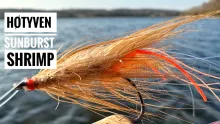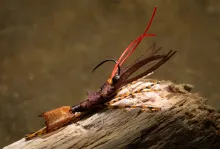Intruders have been around for many years, but if you are new to this fly style, this could be a good place to start.
The intruder style of flies was most likely originated by Ed Ward, a US west coast angler, who developed the pattern for Alaskan salmon as well as his local steelhead in the early 90's. Back then the intruder was a more subdued pattern in natural colors like olive, not unlike a small sculpin.
The pattern was successful and with the help of fellow anglers and guides like Scott Howell, Jerry French, Dec Hogan and others, Ward developed the fly into a concept more than a specific pattern.
The advantage
The advantage of the Intruder is that it enables you to tie a fairly large fly without using a large hook. It also adds weight in the form of a shank and it allows the hook to be mounted trailing in the rear of the fly, a style favored by many salmon and steelhead anglers, who are sometimes seen fishing tandem flies or other flies with trailing hooks.
Intruders have developed into a very large family of flies, and while some still maintain the duller colors of the original, many have taken on the colors of more traditional salmon patterns in the blue, red and black specter while others have donned the colors of modern flies for steelhead and Pacific salmon, mainly pink, purple and orange hues.
Basic construction
They all maintain the same basic construction: a fairly long fly tied in two sections on a front shank, mounted with a short trailing hook on a wire, the rear hook often referred to as a stinger hook.
The original fly was tied on an 8X long streamer hook from Mustad known as the 94720 or R79. Mustad themselves call it the R79NP-BR and says that it's 9X, but that's another story. The essence is that it's a long hook – very long, actually – and that you cut off the hook point when you use it on intruders. Leave the point on while tying, but clip it off when done. It's used in large sizes such as 4 and 2, and trailed by a stinger hook, oftentimes a short shank bait hook like the Owner 5111-113 that Ward used in a size 1/0.
Other hooks can be used, and these days you don't even need to maraud a full hook, but can tie the fly on a shank made for the purpose. The market is rich on materials for intruders in the form of shanks and wire. Intruders are also perfect to tie on tubes, and a long tube, a junction tube and a small single hook makes the perfect foundation for an Intruder.
Shank types
There are basically three types of shanks:
- Long shank hooks, bend and point cut off
- Simple one-eyed shanks
- Waddington style, two-eyed shanks
The two first are essentially the same once the bend and point is cut off the hook, but shanks in the last group are made for the purpose.
The last group consists of a row of different products made for the purpose, including the “real”, classic Waddington shanks as well as more recent dedicated Intruder shanks. These are made from a wire bent back to form eyes in both ends. The eye shapes vary. Mostly the front eye is an upwards bent salmon fly eye, while the rear one is straight, but can be both horizontal and vertical.
The shanks can be found in different weights and lengths from short and delicate Waddington shanks to long and really heavy Intruder shanks. Colors also vary from natural steel and traditional black to all kinds of anodized colors.
You can read much more about shanks, wires and hooks, sources, manufacturers and DIY shanks in an upcoming article on that specific subject.
Some patterns with step-by-step guides will be added as soon as I get them made.
Intruder characteristics
Most Intruder flies are characterized by one or several of the following things:
- Tied in two sections
- Large and mostly heavy
- Relatively small trailing single hook
- Often quite generously dressed
- Long and often bushy hackles
- Often colorful
The Intruder style almost begs you to go crazy, and it's a great fly style to adorn with all the funky materials you have in your stash: long, gaudy hackles like ostrich or fluffy marabou, rubber legs of all kinds and colors, feather fibers of all kinds, dyed Amherst being a favorite.
Basic tying method
Most Intruders are tied following this basic method:
A shank or a long shank hook is mounted in the vise and a wire loop for a trailing hook is tied to it, double wire the full length of the fly, and the loop large enough to allow a hook to be mounted. Some tyers mount the hook before tying, some after or even at the water.
The fly is tied on the shank in two distinct sections each consisting of a supporting shoulder of dubbing or a hair hackle often made from stiff hair like bucktail. On top of each you tie a larger hackle using ostrich, Amherst, marabou or some other long fibered and mobile feather. Quite a few Intruders are tied with natural hair like Arctic fox or similar, but feathers are more common.
The body between the two hackles is usually pretty simple, made from tinsel, dubbing, chenille or yarn, sometimes ribbed.
Many patterns call for rubber legs, flash or other synthetic materials added to or even replacing the hackles, which often consist of several colors mixed to form large and gaudy flies.
Variations
There's a number of variations to this basic style, but here are a few named ones.
Squidros: The Squidro is a particular Intruder style originated by Scott Howell and characterized by two distinct and very mobile rubber leg “hackles”. The fly is tied in two sections as above with an open body and large, and very mobile front of bent back rubber legs, and is often equipped with heavy dumbbell eyes.
Spey Intruders: Some Intruder patterns are tied with a single section in the front, much like a normal wet fly, but with a much larger and longer hackle, much like classic Spey flies. These are not considered to be “true” Intruders by the die hard intruder fans, but never the less have a lot in common with the double Intruder.
They essentially become lightweight Intruders, perfectly suited for lighter rods and much easier to handle and cast than the super heavy Intruders fancied by in particular those fishing for large steelhead and Pacific salmon.
Scanditruders: The Scanditruder is a combination of the Scandinavian style, winged salmon fly and the Intruder. Tied with a ventral/dorsal orientation rather than the round Intruder style, but maintaining the Intruder style trailing stinger hook.
The Scandinavian style fly has been covered in depth here and is mostly hair winged or sporting a short zonker strip or two supported by hackles, and this style can of course be tied on a shank or a tube and equipped with a trailing hook, yielding something, which is a very nice hybrid between the two styles. Tied on lighter shanks, these flies are very well suited for the slower of the Scandinavian salmon rivers.
Mini Intruders: Some tyers tie really small intruders, which are lightly dressed, short lightweight shanks with hooks in the 8 and 10 range. These can be used like any streamer for smaller salmon and brown trout, offering the same advantages as the intruders: a fairly large fly compared to the hook size.
These flies kind of contradict the whole idea of the Intruder, namely creating a large fly without using a large hook. The smaller flies could essentially just be tied on a long shank hook and still be manageable, but the Intruder style is of course cool – and fun to tie!
Tandem Intruders: The main trait of these flies, is that both the front shank and the rear hook is dressed like it's known from some classic tandem flies. This type of fly resembles the normal Intruder, but brings its two sections even further apart, and covers the trailing hook with material, giving it a little more life and mobility.
Mounting the hook
Hook mounting can be done in several ways and in several stages of the tying: before materials are added, during the tying or even at the water.
The attachment techniques vary. The most common way is a wire loop tied onto the shank with or without a rear eye as mentioned above. The hook is then mounted on this loop, simply by passing it through the hook eye, tipping the hook through the loop and then pulling it tight.
Martin Joergensen
Some anglers use no loop, but a method where the line is passed through the front eye, down along the fly and the through the rear eye and then tied to the hook. The fly is then essentially running freely on the tippet like a tube fly. On shanks with no rear eye, like the bent back double wire shanks, some tyers also tie in a small mono loop, that can hold the tippet in the rear end of the fly.
With or without a rear eye you can opt for a piece of junction tube as seen on tube flies. This will slip partly over the shank and guide the hook to make it sit right, but allow it to slide away from the fly once a fish is hooked.
Shanks with eyes in the rear also enable direct hook mounting using a small spring ring, allowing the hook to be changed. This isn't seen very often.
The rear eye is mainly there to allow a good vise grip and can simply be left unused in most cases.
- Log in to post comments































Jerry French in April's podcast
Hi Jørgen, great article as always on your site. April Vokey has a long chat with Jerry French in one of her podcasts here http://www.aprilvokey.com/podcasts/, scroll down to the February 18, 2016 entry, where they discuss the origin and development from Jerry's point of view.